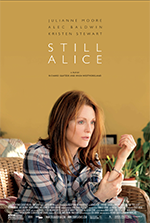
Mastering the Art of Losing
"I’ve always been so defined by my intellect,
my language, my articulation . . ."
Still Alice (2014)
Points
for Reflection
Eva Feder Kittay's "Centering Justice on Dependency and Recovering Freedom (DSR 305-12)
- What does Feder-Kittay mean when she asserts that "the world as philosophy portrayed it" reserved no space for a person like her daughter?
- Do you agree that "a lack of malice, anger, or any sort of viciousness" constitutes "moral agency" (DSR 306)?
- Presented with theories of justice that could not accommodate the particular conditions of her daughter's existence, Feder-Kittay sought to alter the theories themselves. Does this strike you as arrogant, courageous, or absurd?
- Feder-Kittay replaces the Rawlsian conception of justice as "fair terms of social cooperation" with what guiding principles?
- Why might trust be absolutely necessary in any model of justice that rests on interdependence?
- Why does Feder-Kittay call independence a "fiction"?
- What core differences distinguish covenant from contract, as defined by Feder-Kittay? [a covenant protects and provides for those not in a position to weigh in on the initial terms of agreement--either because they lack the capacity to do so (as w/ the cognitively disabled, animals, and the land itself), or because they are not yet part of the particular society/environment: DSR 308]
- Like Tom Shakespeare, Eva Feder Kittay questions the social model of disability's privileging of independence given that some impairments require caregiving assistance. In fact, she argues, everyone relies on some form of support network--whether they admit this or not (DSR 309-10). To which forms of support which help you sustain your own existence are you least likely to admit?
- The activist narrative that privileges independence above all else can run into what limitations?
- What unquestioned dependencies does Feder-Kittay list in her search for things upon which we rely without question?
Richard Glatzer’s and Wash Westmoreland’s Still Alice (2014)
- Is it easy to track how much time elapses between consecutive scenes?
- What are the earliest signs that Alice has begun to experience memory lapses, and how effectively does she move through these early incidents?
- What sorts of self-care does Alice regularly perform, and does she maintain these as her mind deteriorates? [Elizabeth A]
- What camera tricks do the filmmakers use to capture Alice’s moments of disorientation?
- What stylistic choices do the directors make when capturing Alice’s testing sessions with the neurologist, and how does this shape our understanding of what’s happening?
- Can Alice’s sense of identity flex to accommodate significant changes to her functioning?
- How do Alice’s cognitive challenges impact her marriage?
- How do Alice’s issues impact relationships with each of her children?
- In what parts of the house in New York City do Alice’s challenges prove most difficult, and in what locations do her difficulties prove inconsequential?
- How does Alice’s eventual diagnosis impact family dynamics?
- Does Alice attempt to hide her problems from others?
- How much can technology assist Alice as her powers of memory weaken?
- How do the filmmakers manipulate camera focus to convey Alice’s difference?
- Why does Alice begin to wear a butterfly necklace given her by the mother who died when Alice was very young?
- Does the family’s beach house provide solace lacking in the city?
- Do Alice’s cognitive challenges effect long-term memories as much as short-term memories?
- Does Alice weaponize her disability at any point?
- How does the Chekhov play in which Lydia performs tackle themes present in the rest of the film?
- Is Alice’s presence at the play a blessing for Lydia?
- Why does this disease hit Alice so hard and fast?
- Which skills does Alice hold onto most tenaciously, and which fade most quickly?
- How does Alice’s preparation for a speech at the Alzheimer’s Association meeting differ from speech prep at the beginning of the movie?
- Which family member accompanies Alice to the Alzheimer’s Association meeting, and how does this individual react to her presentation?
- Which memories does Alice identify as most important to her? [Hannah R]
- Is Alice still able to enjoy life once her disease has progressed enough to eliminate her job?
- How does Alice respond to her husband’s new job opportunity?
- Why does Alice’s misplacing her phone so unsettle her?
- Does Alice’s family become increasingly comfortable talking about hard issues around her, or less comfortable?
- What skill does Alice demonstrate at the hospital?
- What does Alice do when she happens upon the video she created for herself earlier?
- Why does John call Lydia a “better man” than himself?
- Is Alice able to track the poetic lines Lydia shares with her at the end of the film?

Richard Glatzer’s and Wash Westmoreland’s Still Alice (2014)
one poster from original film release
Dr. Paul Marchbanks
pmarchba@calpoly.edu
![]()
